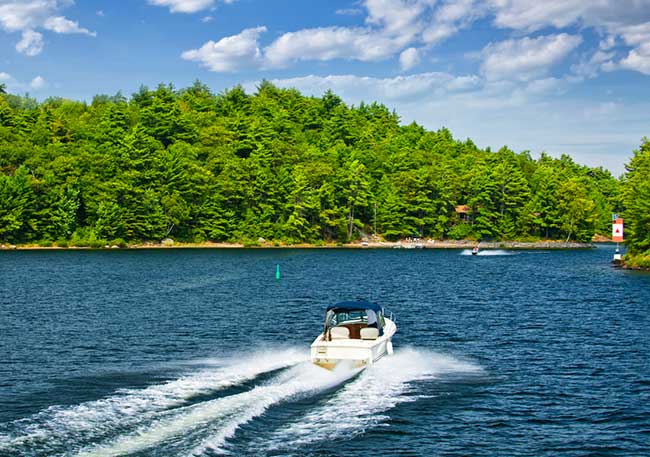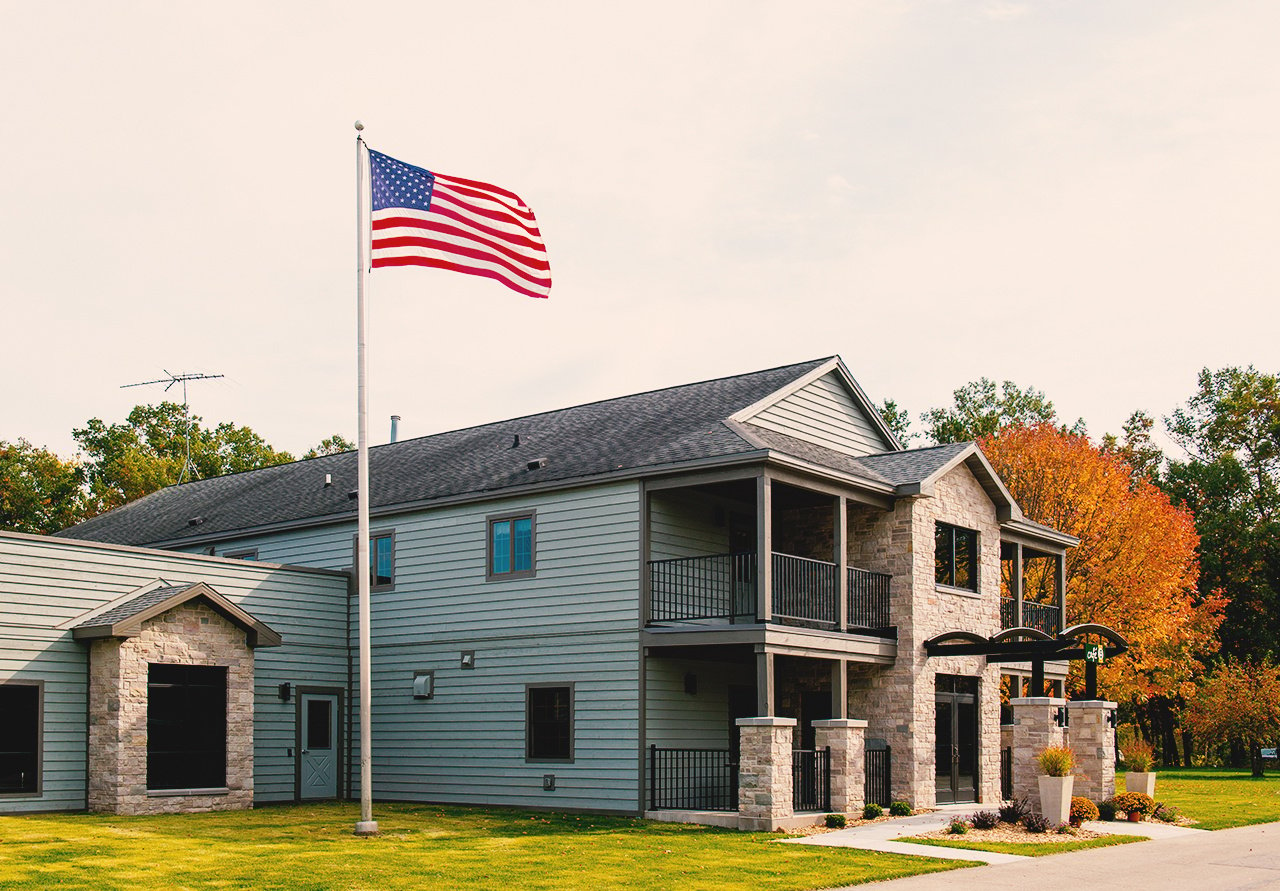
When sunshine starts dancing on the lake, boaters will be eager for some warm-weather fun. Before your boat hits the water though, ensure your boat is ready. Preparing your boat for spring ensures proper performance and safety. These 101 tips for preparing your boat for spring will give you peace of mind and get you on the water in no time.
General Tips for Preparing Your Boat for Spring
- Check that the boat registration is current and onboard. You need to have this available if a Department of Natural Resources (DNR) officer asks to see it.
- Clean the hull with a marine-safe cleanser. Avoid using dish soap as it may remove wax.
- After cleaning the hull, apply a coat of wax to protect the finish.
- Clean windows and hatches to ensure unobstructed visibility.
- Inspect wiper blades and replace if necessary.
- Check that drains and scuppers are clear. Clean as needed so that water can properly drain off instead of pooling in your boat.
- Clean and polish metal with a good metal polish.
- Invest in boat towing insurance. You’ll be glad you did if an emergency arises.
Inspecting Your Boat’s Electrical System and Components
- Check the boat’s battery. Recharge as needed.
- Inspect battery terminals for corrosion. If battery terminals appear corroded, clean.
- Check the water level of the boat’s battery. If water level is low, add distilled water to maintain battery’s performance. Tap water will diminish performance.
- Check that the boats bonding system is functioning. The bonding system is used to connect a boat’s underwater metals such as through-hull fittings and rudders.
- Inspect all wiring for wear and fraying. All wires should be intact and secure.
- Test all gauges for proper function.
- Check the boat’s shore power system and make sure the charger is working. This will save fuel consumption while idling.
- Add spare fuses to the boat’s storage compartment in case a fuse burns out.
- Test all lighting fixtures and replace burned out bulbs. Store spare bulbs on your boat.
- Make sure that antennas are secure.
- Inspect the outer jacket of the throttle, shift, and steering control cables for cracks or swells. These may mean internal corrosion and failure.
- Check functionality of all other electronics on the boat such as fish finders and radios.
- Apply corrosion-inhibitor product to all metal connections. Some products also work as a lubricant to loosen rusted parts.
Hull Inspection
- Examine the hull for stress cracks in the fiberglass.
- Check the hull for blistering. An occasional blister is not a serious problem, however many large blisters threaten the integrity of the hull. Repair immediately.
- Inspect the rudder and fittings for rust, corrosion, bearing debris, and excessive play.
- Check and replace zinc anodes if necessary. Zincs guard against galvanic corrosion that can quickly destroy underwater metals like your rudder or outboard.
- Check that rub rails are secure and that there are no leaks underneath it.
- Inspect that the shaft, cutlass bearing, strut and prop are in working condition.
- If applicable, check the swim platform and/or ladder for any damage or loose connections.
- Inspect and test trim tabs.
- Touch up or replace any antifouling paint to slow the growth of underwater organisms that attach to hulls. A buildup of organisms can decrease the boat’s performance.
Check Below the Decks
- Inspect and lubricate seacocks—valves in a boat’s hull below or near the waterline that permits water flow into the boat for various purposes like a sink. Once inspected and lubricated, test.
- Make sure hoses and clamps are in working condition.
- Waterline hoses should be double clamped. Check that this is so.
- Check limber holes and make sure they are clear of debris and functioning correctly.
- Bilge pumps should be inspected for proper automatic and manual operation.
- Inspect the bilges to make sure no oil leaked in during the offseason.
Inspect Inboard Engines
- Before firing up the engine, change oil and oil filters. Be sure to carry spare oil and filters onboard.
- Inspect the fuel filter and change if dirty. It’s always wise to carry an extra fuel filter.
- Take a look at the cooling system. If coolant is discolored, change it. Always have extra coolant onboard.
- Check for discoloration in transmission fluid. If transmission fluid appears discolored, it’s time to change it for new fluid.
- Check all belts for tension, fraying, and wear. Also check that all belts are aligned properly and that no belts are slipping.
- Check and clean backfire flame arrestor These prevent gasoline vapors from igniting if your engine backfires. Each carburetor needs one.
- Check impeller to make sure fluid is being transferred evenly through the engine.
- Inspect and clean your boat’s raw water strainer to prevent marine growth.
- Check that the bilge blower is properly ventilating gasses.
Checking the Outboard Motor
- Check that spark plugs hold a spark. Replace spark plugs if necessary.
- Inspect, change, and fill gear lube if necessary.
- Check your fuel lines, primer bulb, and fuel tank for leaks.
- Lubricate and spray moveable parts to protect from wear and damage.
- Inspect the propeller for damage or warping. Fix if necessary.
Examine Mast and Rigging (If Applicable)
- Check mast and spreaders for corrosion or damage.
- Inspect that spreader boots and shrouds are in working condition to prevent damage to sails.
- Examine rivets and screw connections to be sure no corrosion occurred.
- Clean sail track to ensure proper function.
- Check rigging, turnbuckles, and clevis pins for wear and corrosion. Regular inspection can prevent later damage from corrosion.
- Inspect all stays for fraying or other damage.
- Check that reefing points and reefing gear are functioning for proper sail functions.
- Check the sail’s forestay and backstay connections to ensure it is properly connected.
- Inspect that masthead fitting and pulleys are functioning appropriately for proper furling and unfurling.
- Check and lubricate roller furling system so sails can successfully furl and unfurl.
- Check halyards for damage or frays and consider replacing if damaged or frayed.
- Apply tape to your turnbuckles, cotter pins, and spreaders to prevent any snags or damage to sails.
- Lubricate the stuffing boxes, shaft and rudder logs to ensure proper movement.
- Empty and consider replacing water separator filters to allow better fuel efficiency.
- Shock the drinking water tank if applicable. Pool shock is recommended as it breaks down in a few days and then can be flushed out.
Check Deck, Fittings, and Safety Equipment
- Examine that ground tackle, lines, fenders, and other docking equipment are in working condition to prevent any mishaps when docking the boat.
- Check that chainplates and cleats are secure to ensure safe docking.
- Inspect deck for leaks and check that all windows and port lights are properly secure to prevent any water coming where it shouldn’t.
- Inspect anchor windlass and lubricate moving parts on the mechanism if necessary to allow for proper anchoring.
- Clean and grease winches for effective and efficient use.
- Examine that blocks and pad eyes are secure to the boat to prevent anything tied to them from ripping them out.
- If applicable, check stanchion, pulpits and lifelines. Ensure that they will remain in place, especially under human weight.
- If applicable, inspect that dinghy and/or life raft are in working condition. It’s wise to know emergency vessels will work if needed.
Inspect the Sails (If applicable)
- Inspect the sails for wear, chafing, and any other damage. If sails are damaged, replace to prevent issues on the water.
- Examine that battens and batten pockets are properly maintained to retain proper sail shape.
- Check all sail attachments to ensure your sail won’t create problems unfurling, furling, or when the wind picks up.
- Inspect the bolt rope for fraying or weakness. If frayed or weak, replace to prevent problems when you’re in the middle of the water.
Other Required and Recommended Equipment
- Check all distress signals on the boat, including the expiration dates. Emergency flares may not work if they’ve been sitting for a long while or if they were improperly stored. Buy new distress signals if there’s a chance the ones on hand might now work.
- Carry enough life jackets and personal flotation devices for passengers. Make sure every passenger has access to an appropriate life jacket.
- Ensure that all boat cushions are in good condition. They may also be used as flotation devices.
- Check that fire extinguishers are up to date and recharge if necessary.
- Check and adjust compass so it gives accurate bearing.
- Inspect navigation lights for malfunctions and adjust as needed.
- Check that nautical charts and maps are up to date and replace if necessary. Surprises aren’t always great when you’re in the middle of the water.
- Ensure that the radar reflector is functioning properly. This ensures that your boat shows up on other radars.
- Check that first aid supplies are up to date and replace if expired or if supplies are running short.
- Check that the bailer has no cracks and that the hand pump is in working condition. You will be glad you did in case of leak.
- Consider stocking potatoes on board. They can be used as an emergency food source and an emergency plug if a leak arises.
- Epoxy sticks can be kept on board as emergency fix-it adhesives if something breaks or needs to be put back together.
- Extra-Large garbage bags are a valuable item to have on board as they may be used as emergency ponchos or to help seal a leak.
- Keep duct tape on board. Duct tape is a versatile fix-it that helps in a variety of ways if something breaks.
- Include white vinegar as a staple on board. White vinegar is handy for curing itches if you encounter pesky mosquitos, or if you meet a jellyfish.
- Wax candles are a great addition on a boat because they can help lubricate jammed zippers, broken snaps, or anything with moving parts that might be stuck.
And Now for the Trailer…
- Check that the trailer’s rollers are in good, working condition so that guiding the boat back onto the trailer goes smoothly when you’re done for the day.
- Check that your trailer’s turn signals work. It’d be a shame to get pulled over before you start boating.
- Inspect the brake lights on your trailer so drivers know when you’re slowing down or stopping.
- Check that the straps and chains are in working condition and will be able to hold your boat in place.
- Apply lubrication to your winch if it is stiff. Proper lubrication allows for your winch to haul and secure your boat easier.
- Look at the latch on your coupler and make sure it is still working. A broken latch may cause the trailer to escape.
- Inspect wheel bearings and repack them with grease if necessary. Poor wheel bearings can create uneven wear for trailer tires.
- Check that your registration on your trailer is current. Many states require up-to-date registration for trailers.
Finished Preparing Your Boat for Spring?
Preparing your boat for spring may be painstaking, but having peace of mind while you’re on the water all season lets you enjoy the summer. If you’re looking to find a boat, check out Rawhide’s eBay selection. We have many boats up for auction that can fill your life with happy boating.










